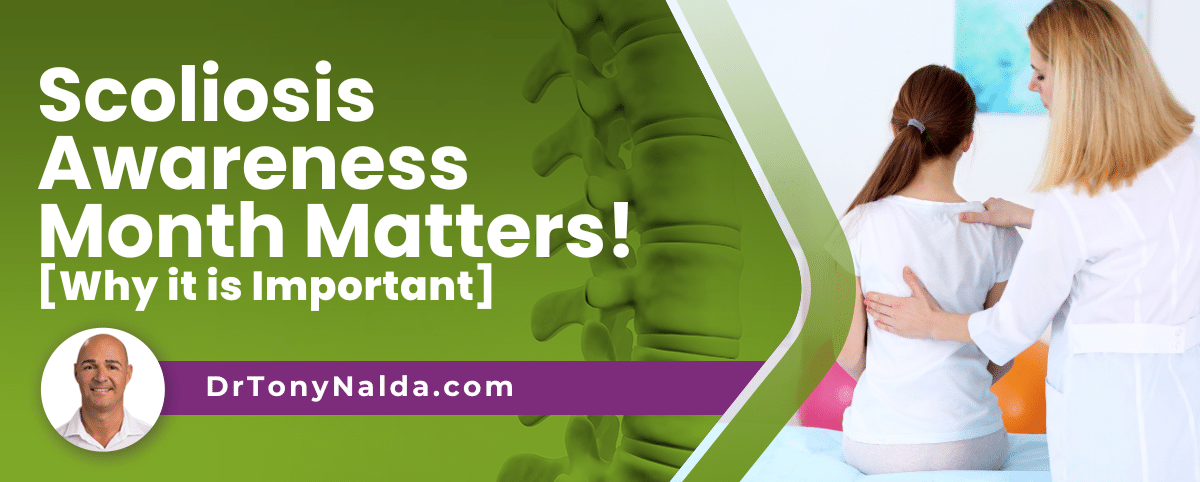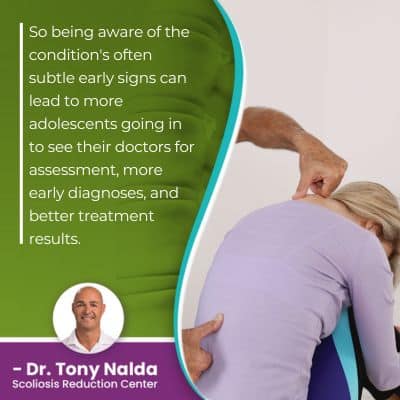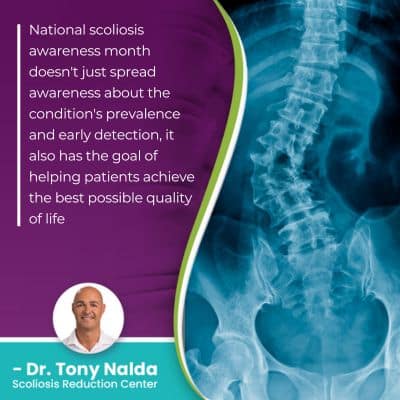Scoliosis Awareness Month Matters! [Why it is Important]

What I want people to understand the most about scoliosis is that as a progressive condition, being proactive with treatment is key and can help patients avoid the potential risks, side effects, and complications of surgical intervention.
June is National Scoliosis Awareness month; this is important because as the leading spinal condition to affect school-aged children, and with current estimates at close to seven million people living with scoliosis in the United States alone, scoliosis is highly prevalent and warrants awareness.
As early detection can be so beneficial, let's start with how scoliosis is diagnosed.
Table of Contents
Diagnosing Scoliosis
Diagnosing scoliosis means an unnatural sideways-bending and rotating spinal curve has developed, and the spine's natural and healthy curves keep it strong, flexible, and better able to absorb and distribute mechanical stress during movement.
So if the spine develops an unhealthy curve, this doesn't just affect one area of the spine, but disrupts the entire spine's biomechanics.
The rotational component means a scoliotic spine isn't just bending to the side unnaturally, it's also twisting, and this makes it a complex 3-dimensional condition.
In addition to bending and twisting requirements, in order to be diagnosed as a true scoliosis, the scoliotic curve has to be a minimum size: Cobb angle measurement of at least 10 degrees.
A patient's Cobb angle is determined during X-ray and tells me how far out of alignment the spine is and classifies conditions based on severity.
The higher the Cobb angle, the larger the scoliotic curve is, the more severe the condition, and the more noticeable its effects are likely to be.
While there are no treatment guarantees, with early detection and intervention, there are fewer limits to what can be achieved, and that's why scoliosis awareness month is important: because it spreads awareness of the importance of early intervention and how to recognize the condition's early signs.
Awareness Leads to Early Detection
Spreading awareness about a condition means that people are not only more aware of its prevalence, but also its characteristics, such as early signs to watch for.
Now, when it comes to scoliosis, there are different types, and this is determined by causation.
 The most common type of scoliosis to affect all ages is idiopathic scoliosis, and this means not clearly associated with a single-known cause, and while scoliosis is more commonly diagnosed in children, it affects all ages.
The most common type of scoliosis to affect all ages is idiopathic scoliosis, and this means not clearly associated with a single-known cause, and while scoliosis is more commonly diagnosed in children, it affects all ages.
The most prevalent type of scoliosis overall is adolescent idiopathic scoliosis, diagnosed between the ages of 10 and 18.
Approximately 80 percent of known cases are idiopathic, and the remaining 20 percent have known causes: neuromuscular scoliosis, congenital scoliosis, and degenerative scoliosis.
As adolescents are most often diagnosed with scoliosis, let's focus on the benefits of early detection when treating adolescent idiopathic scoliosis.
While we don't know what causes idiopathic scoliosis to develop, we know what triggers it to progress: growth.
Adolescents are the most at risk for rapid-phase progression because of puberty and its rapid and unpredictable growth spurts, and as scoliosis gets more complex to treat as it progresses, starting treatment early in a condition's progressive line can mean preventing it from getting worse.
So being aware of the condition's often subtle early signs can lead to more adolescents going in to see their doctors for assessment, more early diagnoses, and better treatment results.
So what are the early indicators of adolescent idiopathic scoliosis?
Early Detection can Help with Treatment Success
As scoliosis progresses, the spine gets increasingly rigid, making it less responsive to treatment, and increasing spinal rigidity can make it difficult for some patients to perform key therapeutic exercises as part of treatment.
As scoliosis gets worse, the size of the unnatural spinal curvature is increasing, as are the condition's uneven forces, and their effects, but with treatment success, many of the condition's effects can be minimized, and/or reversed.
It can be challenging to diagnose scoliosis while mild because oftentimes, mild scoliosis causes subtle postural changes, isn't associated with functional deficits, and as scoliosis doesn't become a compressive condition until skeletal maturity has been reached, it's not commonly painful for children.
In adolescents, the earliest telltale signs are often uneven shoulders and hips, and additional types of postural changes can include:
- The head appearing uncentered over the torso
- One shoulder blade protruding more on one side than the other
- The development of a rib cage arch
- One hip sitting higher than the other
- An uneven waistline
- Arms and legs that appear to hang at different lengths
Spinal disorders can cause a wide range of effects felt throughout the body, and not just in the back, and in severe cases and/or if left untreated, scoliosis is associated with the following potential serious complications:
- Disruptions to heart and lung function
- Chronic back pain
- Chronic nerve pain
- Digestive issues
- Headaches and migraines (due to disruptions in the flow of cerebrospinal fluid)
Scoliosis screening during a physical examination will look for early condition indicators that warrant the need for other imaging tests to truly see what's happening in and around the spine and to reach a diagnosis of scoliosis.
Once scoliosis is diagnosed, the most important decision to be made is how to treat it accordingly because how scoliosis is treated can shape long-term spinal health and function.
If scoliosis is diagnosed while mild, there are fewer limits to what can be achieved simply because smaller curves are easier to treat, and it's far more effective to work towards preventing progression through proactive treatment than it is to work towards reversing the condition's effects once they're established.
But the benefits of early detection are only available to patients committing to a proactive treatment approach, and this means modern conservative treatment and the goal of avoiding invasive spinal surgery.
So when an early diagnosis is met with a proactive treatment response, awareness and early detection can also help patients avoid the need for invasive surgical treatment options in the future.
Early Detection can Help Patients Avoid Surgical Treatment
 While there are never treatment guarantees, as a progressive condition, the best time to start scoliosis treatment is always now.
While there are never treatment guarantees, as a progressive condition, the best time to start scoliosis treatment is always now.
National scoliosis awareness month doesn't just spread awareness about the condition's prevalence and early detection, it also has the goal of helping patients achieve the best possible quality of life.
I want people to be aware that while traditional surgical scoliosis treatment was the dominant choice for many years, that doesn't mean it was the best or only treatment option available, and with awareness and early detection comes the opportunity for modern treatment to take hold.
Here at the Scoliosis Reduction Center, my conservative non-surgical treatment approach has proven results, showing that not all cases of scoliosis require surgical treatment.
If a patient's scoliosis progresses into the severe classification, if on the path of traditional treatment, they become a surgical candidate, and in these cases, had proactive treatment been applied earlier, it's entirely possible that the abnormal curvature of the spine wouldn't have progressed to the point of needing surgical intervention.
Scoliosis surgery is a type of spinal fusion that involves fusing the curve's most-tilted vertebrae into one solid bone so they can't become more unnaturally tilted, but this also eliminates movement in the fused portion, and this is contrary to the spine's movement-based design.
Many patients are disappointed that their pain increases after the surgery, and a noticeable loss in spinal flexibility and range of motion can disrupt overall quality of life, and a spine that's fused and held in place by rods and screws is going to be weaker and more vulnerable to injury.
Conclusion
Scoliosis awareness month is June and unites scoliosis patients in an effort to raise awareness through grassroots networking, collaborative partnerships, highlighting educational resources, and a public initiative to educate and foster understanding about scoliosis prevalence and the benefits of early detection.
Once a spine is fused, it's fused for life, and if the spinal fusion is unsuccessful, the only recourse is more surgery, but conservative nonsurgical scoliosis treatment involves preserving as much of the spine's natural strength and function as possible; the more aware people are about scoliosis, its telltale signs, and early detection, the more likely it is that conditions will be recognized and approached proactively.
Even when the exact cause of scoliosis is unknown, we know that it's growth triggering it to get worse, which is why scoliosis in children should be taken seriously, and when it comes to a medical condition that's progressive and incurable, but can be highly treatable, reaching those early diagnoses is key.
So this June, take some time to educate yourself on the condition's early signs so you can recognize them in family members you care about; this awareness can lead to early detection, treatment success, and avoiding the potential risks of surgical treatment.
Dr. Tony Nalda
DOCTOR OF CHIROPRACTIC
After receiving an undergraduate degree in psychology and his Doctorate of Chiropractic from Life University, Dr. Nalda settled in Celebration, Florida and proceeded to build one of Central Florida’s most successful chiropractic clinics.
His experience with patients suffering from scoliosis, and the confusion and frustration they faced, led him to seek a specialty in scoliosis care. In 2006 he completed his Intensive Care Certification from CLEAR Institute, a leading scoliosis educational and certification center.
About Dr. Tony Nalda
 Ready to explore scoliosis treatment? Contact Us Now
Ready to explore scoliosis treatment? Contact Us Now





